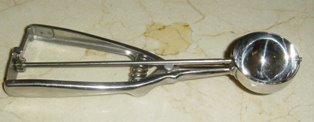
I’ve been itching to make croissant since a very long time and I finally made a dip to commit myself to make it and eventually dedicated to succeed in making one which was quite a challenge for me. I didn’t make it perfect, but its edible so-to-speak, anyway, hubby and I were the only judge and we evaluated the result. It wasn’t flaky enough and the layers of dough are a little bit thick as it should be. It took time to cook that what was stated in the recipe, the recipe says 15-20 minutes at 190 degrees C to brown but it took 45 minutes to brown. My croissants didn’t fluff much.
I’m not giving up just yet, I’m going to make it again.
I’m trying to figure out where did I went wrong in the process and possible factors and concluded the ff:
a) The recipe didn’t say what particular kind of flour to use, I used Bread flour type “00” Maybe there is not enough gluten in the flour causing the dough not so elastic.
To correct: use flour with high gluten content.
b) The flattened butter was a little bit thick and there was not enough space to spread it thinly, so during the folding process, some of the butter got out of the dough folds at the sides.
To correct: Allow a space at least about 2 inch at the sides to seal the dough when the butter is folded in.
My source of the recipe is from video jug;The video looks very easy to do, all you need is patience. The text version of the recipe I just paste it below; for easy reference.
CROISSANTS
You will need:
· 500 g flour
· 15 g active dry yeast
· 90 g sugar
· 15 g salt
· 300 ml warm milk
· 340 g butter , room temperature
· 1 egg, beaten with 2 Tbsp water
· some extra flour
· 1 rolling pin
· 1 knife
· 1 baking tray lined with parchment
· 1 mixer with hook attachment
· 1 mixing bowl
· 1 tea towel
· 1 plastic bag
· 1 brush
Step 2:
Begin the dough
Put the flour into the mixer. Add the salt, sugar, milk and yeast. Mix it on low for 8-10 minutes until it has a smooth elastic consistency. Dust the dough and a large bowl with flour. Remove the dough from the mixer and transfer it into a bowl. Cover it with the towel and let it rise until it doubles in size. This should roughly, take 1.5 to 2 hours.
Step 3:
Prepare the butter
Put a sheet of cling film onto your working surface. Place the butter on top and cover it with a second sheet of cling film. Flatten it with your hands, roll it into a rectangle of about 20 X 25 cm with your rolling pin and place it into the fridge to chill.
Step 4:
Roll out dough
After the dough has doubled in size, sprinkle it with a little bit of flour. Punch out the air with your knuckles and place it onto a floured work surface. Dust the dough with flour and roll it out into a large rectangle that is big enough to hold the sheet of chilled butter. Move the dough around in the flour. You may have to dust the table again, if you need to.
Step 5:
Fold in butter
Unwrap the chilled butter and place it onto the upper part of dough. Fold the dough around the butter to enclose it completely. Lift the dough and sprinkle the table with flour. Turn the dough around and roll it into another long rectangle. Fold the dough into thirds, brushing off the excess flour as you go. This completes the first turn. Now wrap it in cling film and place it into the fridge for a minimum of 25 to 30 minutes.
Step 6:
Turn the dough
At the end of the 30 minutes sprinkle your working surface with flour. Unwrap the dough and place it onto the work surface. Make sure that the dough has the seam vertically placed. Dust it with a sprinkling of flour and roll it out into another rectangle. Fold, brush and wrap, exactly as before. This now completes the second turn.
Step 7:
Chill and turn again
Place it back into the fridge for another 30 minutes. Once removed, roll and fold for the third and final turn. Make sure that the dough is well wrapped before placing into the fridge once more to chill overnight.
Step 8:
Shape the croissants
One chilled, cut the unwrapped dough into half, on a floured surface. Dust the dough with some flour and roll one half of the dough into a rectangle. Reflour the surface when necessary and continue to roll until the dough is roughly less than half a centimetre thick. Turn the rectangle around. Flour the surface and trim the edges of the dough neatly. Cut it into triangle shapes. Take the bottom of the triangle at its widest part and using your hands, tightly roll it up into a croissant shape. You can freeze the other half of the dough for use another time, or repeat the process and make more croissants.
Step 9:
Allow to rise
Place the croissants onto a prelined baking tray. Cover them with a clean plastic bag and leave to double in size.
Step 10:
Preheat the oven
Set the oven to 190ºC (375ºF/ gas mark 5).
Step 11:
Wash and bake
Once the croissants have risen remove the plastic bag. Very gently brush them all over with the egg wash. Place them into the centre of the oven. Bake them for roughly 15 minutes. When they are a deep golden brown remove them from the oven.

































